
A fleet of new trains to carry commuters between Ōtaki and Wellington will be at least five years away.
The government announced recently that 18 new hybrid diesel/electric four-car trains would be introduced on the Kāpiti Coast and Wairarapa lines to replace KiwiRail’s ageing fleet. Improvements would also be made to the tracks.
However, Ōtaki commuters have little to be excited about just yet.
Greater Wellington Regional Council’s public transport operator, Metlink, says it’s unlikely the trains will be in service for at least five years.
“This is dependent on the duration of a tender and several other procurement processes,” Metlink general manager Samantha Gain told Ōtaki Today. “However, our aim is for the new trains to be running Metlink passenger services between Wellington and Palmerston North by late 2028/early 2029.”
GWRC’s chair, Daran Ponter, was excited about the train investment.
“The new trains will revolutionise life for commuters in the Wairarapa, Hutt Valley, Manawatū, Horowhenua and Kāpiti, who need access to Wellington, Porirua and Palmerston North,” he said.
However, compared to the train services the rest of the Kāpiti Coast enjoys, and the Wairarapa, Ōtaki is still sold short.
At present, only one service – the Capital Connection – operates between Palmerston North and Wellington. It picks up passengers in Ōtaki about 7.15am, and returns them about 6.20pm.

CONNECTING: The Capital Connection train at its early morning stop in Ōtaki. It’s the only direct connection for commuters to and from Wellington.
Photo Ōtaki Today
With the new trains, the number of weekday peak time services through Ōtaki would double.
The proposed scheduling of the new trains would enable two morning peak south-bound trips from Palmerston North to Wellington. These trains would return to Palmerston North at off-peak times not long after arrival in Wellington. In the afternoon there would be two north-bound peak services out of Wellington. (Peak refers to weekdays until 9am and from 3pm to 6.30pm). Two weekend services are also planned.
Much-touted as a big boost for Ōtaki, the increased number of trips will offer a better service at peak times, but pales in comparison to Waikanae. The weekday timetable at Waikanae, just 15km down the road, shows a train leaving on average every half hour, providing 48 trips a day.
And in Wairarapa, Carterton, for example, already has the south-bound Wairarapa Connection stopping three times at morning peak hours on weekdays and three times north-bound at afternoon peak hours, with two return services off-peak. That’s five daily services each way (six on a Friday), even before an enhanced service with new trains.
Asked if introduction of the new fleet precluded further efforts to have electrification of the line to Ōtaki to allow a similar commuter service as Waikanae, Metlink’s Samantha Gain said that would still be considered, but it would not take priority over an upgrade to the track.
“As the new trains will operate to a more frequent timetable, often needing to pass trains heading in opposite directions, the preferred option outlines the need for double tracking of railway lines north of Waikanae to be extended.
“These upgrades would take priority over electrification.”
She said electrification of the line from Waikanae to Ōtaki might still be considered to support freight and passenger services in the area.
The new hybrid trains will run using the electrified lines to Waikanae, then battery/diesel from Waikanae to Palmerston North, which will reduce carbon emissions.
“The new fleet of 18 four-car hybrid electric trains will be a far more climate friendly option than the ageing, diesel locomotive-hauled Capital Connection carriages, currently operating on this (non-electrified) section of the line,” Samantha said.
Greater Wellington and Horizons Regional Council (covering the Manawatū region) are putting up 10 percent of the cost for the trains. The remainder is government funded. Costs have not been revealed so far due to “commercial considerations”.
The government’s announcement said travellers would save up to 15 minutes between Palmerston North and Wellington, and emissions on the Manawatū and Wairarapa lines would reduce by more than half a million tonnes.

Ian Carson is editor of Ōtaki Today.
OTHER POSTS FROM THE EDITOR
LATEST POSTS
- No respite for ‘cone town’
- Petition spurred by road works disruption
- Heniti vows to put Ōtaki first
- Trout spawn in Winstone Lakes
- Rāhui Rd next in line for road works
- ‘Monkey’ back to old tricks
- Plenty of choice in election race
- Ōtaki dominates awards night
- Sam risks all for Gaza
- Four now vie for Ōtaki Ward
- Heniti ‘proud to call Ōtaki home’
- Infrastructure works keep rolling on
- An ONZM for arts, sport, heritage
- Trappers aim for predator free Te Horo
- Te Horo hall wants land for car park
- Beach burglars pinch trailer and tools
- Rob throws hat in ring for Ōtaki Ward
- Toilet vandalism ‘tragic, sad’
- Fifty years for Ōtaki fire chief
- Idiots in cars’ block highway
